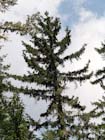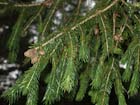
A tree in habitat, Nuevo León, Mexico [Carlos Gerardo Velazco Macías, 2009].

A tree in habitat, El Butano, Nuevo León, Mexico [Jeff Bisbee 2012].

Trees in habitat at base of cliff, El Butano, Nuevo León, Mexico [Jeff Bisbee 2012].

Branch on a tree in habitat, showing foliage and foliar units. The brown growth at the shoot tip is caused by spruce budworm infestation [Carlos Gerardo Velazco Macías, 2009].

Seed cones on a tree in habitat, El Butano, Nuevo León, Mexico [Jeff Bisbee 2012].

Bark on a tree in habitat, El Butano, Nuevo León, Mexico [Jeff Bisbee 2012].

Picea martinezii
T.F. Patterson 1988
Common names
Pinabete, Nuevo León spruce; Pinabete [Spanish].
Taxonomic notes
Considered synonymous with P. chihuahuana Martínez by some authors (Farjon 1990), but proved clearly distinct on detailed analysis, "justifying the retention of P. martinezii as a separate species" in the opinion of Taylor et al. (1994), a determination separately confirmed by Ledig et al. (2004) in an analysis using multiple independent lines of molecular data. Those data, however, also show that the two taxa are sisters, so P. martinezii could reasonably be treated as a variety or subspecies of P. chihuahuana, though those combinations have not to my knowledge yet been made.
Description
A tree to at least 35 m, possibly 40 m tall. Primary branches level, side branches and twigs moderately pendulous on mature trees. Shoots stout, pale brown to orange-brown. Leaves bright green, glossy with inconspicuous stomata (very unlike the matte blue-green of P. chihuahuana), 23-28 mm (vs. 17-23 mm in P. chihuahuana), uniquely in Picea flattened not dorsiventrally but from side to side, exceedingly sharp (readily drawing blood when shoots grasped!) but with a shorter spine tip than P. chihuahuana. Cones green ripening orange-brown, cylindrical, (8.5-)11-16 cm long (vs. 7-12 cm in P. chihuahuana), 5.5-6 cm broad when open with large scales (vs. 4-5 cm in P. chihuahuana; no overlap), scales widely spaced, 12-16 scales crossed in 10 cm length of an open cone (vs. congested, 25-30 per 10 cm in P. chihuahuana; no overlap), 26-32 mm long (vs. 18-23 mm in P. chihuahuana; no overlap), 21-25 mm wide (vs. 14-20 mm in P. chihuahuana; no overlap), apex smoothly rounded (truncated, almost square-ended, in P. chihuahuana). Seed 4-5 mm, black, with a 15 mm wing. (Data from (Patterson 1988, Taylor et al. 1994), M. P. Frankis' Nuevo León field notes and cones in M. P. Frankis collection).
Distribution and Ecology
Mexico: Nuevo León, in the Sierra Madre Oriental (map below). As such, this species is in the Sierra Madre Oriental whereas P. chihuahuana is in the Sierra Madre Occidental at comparable latitudes. Both occur at relatively high elevations (1820 to 2515 m for P. martinezii, 2155 to 2990 m for P. chihuahuana; Ledig et al. 2000) suggestive of relict postglacial distributions, which is consistent with the observations of spruce pollen in the valley of Mexico reported by Clisby and Sears (1955, cited by Ledig et al. 2000), well south of the current Mexican range of the genus. This prompts me to speculate that they may have arisen via vicariant speciation from a common Pleistocene (or perhaps earlier) ancestor. USDA hardiness zone 8.
Locations of the 6 stands inventoried by Ledig et al. (2000).
Hardy to Zone 8 (cold hardiness limit between -12.1°C and -6.7°C) (Bannister and Neuner 2001).
This species is listed as endangered in Mexico under NOM-ECOL-059-94. It was discovered in 1981 (Müller-Using and Lässig 1986), initially at only two sites, one containing a few hundred trees, the other only about a dozen, growing in canyons on moist north-facing scree slopes. The subsequent expansion to six known sites has not identified any large populations (Ledig et al. 2000) and the entire species is thus comprised of only about a thousand trees; as such, it has to be regarded as one of the world's most endangered conifers. "Timber has been extracted in recent years in the larger of the two populations [known at that time]. The other population has fewer than 15 individuals. Fire is the main threat" (World Conservation Monitoring Center 1998).
Remarkable Specimens
Ethnobotany
Observations
Remarks
The epithet honors Maximino Martínez (1888-1964), eminent Mexican botanist who described many conifer taxa.
Citations
Clisby, K. H. and P. B. Sears. 1955. Palynology in southern North America, part III: microfossil profiles under Mexico City correlated with the sedimentary profiles. Bulletin of the Geological Society of America 66:511-520.
Farjon, Aljos. 1990. Pinaceae: drawings and descriptions of the genera Abies, Cedrus, Pseudolarix, Keteleeria, Nothotsuga, Tsuga, Cathaya, Pseudotsuga, Larix and Picea. Königstein: Koeltz Scientific Books.
Ledig, F. T., M. Mápula-Larreta, B. Bermejo-Velazquez, V. Reyes-Hernandez, C. Flores-Lopez, and M.A. Capo-Arteaga. 2000. Locations of endangered spruce populations in Mexico and the demography of Picea chihuahuana. Madroño 47(2):71-78. Available: Biodiversity Heritage Library, accessed 2021.12.19.
Ledig, F. T., P. D. Hodgkiss, K. V. Krutovskii, D. B. Neale, and T. Eguiluz-Piedra. 2004. Relationships among the Spruces (Picea, Pinaceae) of Southwestern North America. Systematic Botany 29(2):275-295.
Müller-Using, B. and R. Lässig. 1986. Zur Verbreitung der Chihuahua-Fichte. Mitt. Dtsch. Dendrol. Ges. 76: 157-169.
Patterson, T. F. 1988. A new species of Picea (Pinaceae) from Nuevo León, México. Sida 13: 131-135.
World Conservation Monitoring Center. 1998. Picea martinezii. http://www.wcmc.org.uk/cgi-bin/SaCGI.cgi/trees.exe, accessed 1998.12.21, now defunct.
This page co-edited with Michael P. Frankis, 1998.12.
See also
The species account at Threatened Conifers of the World.
Capo-Arteaga, M., S. Valencia-Manzo, C. Flores-Lopez, and S. Brahams. 1997. Informe final de actividades del proyecto: autoecologia del genero Picea en Nuevo Leon. Presentado a: Consejo Consultivo Estatal para la Preservacion y Fomento de la Flora y Fauna Silvestre de Nuevo Leon. Universidad Autonoma Agraria Antonio Narro, Buenavista, Saltillo. Coahuila.






